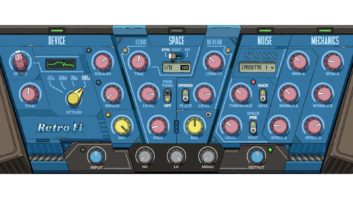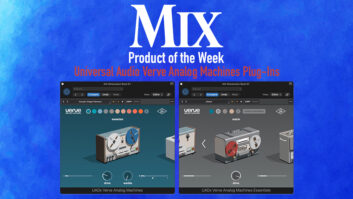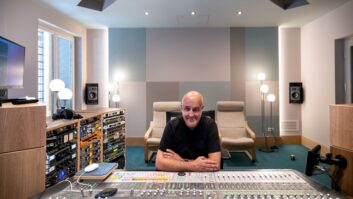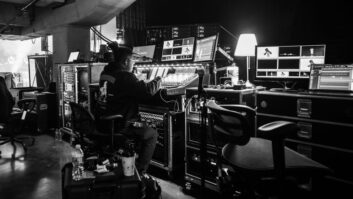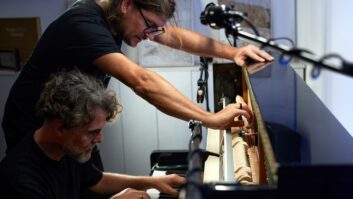Radical recording. Hmm-what do you mean by that?” That’s the response I got from various engineers when I broached the subject of this article. “Well,” I offered lamely, “I think it’s like, uh, when you turn off the Pro Tools and record something without using a plug-in.”
Sad but true, dependence on computer technology seems to be state of the state these days-sad, at least, to those of us who remember turning the 2-inch tape upside down to get a mood-drenched, backward echo; running tape slap (maybe around the heads of an adjoining machine to get a long-enough delay); tuning an acoustic chamber by moving the microphones inside it; and slicing those teeny tiny little slivers of tape off the front of the kick drum to get the drummer more in time. (And then, don’t forget the payoff-pasting those slivers up on the wall to let the drummer, and everyone else, know who the real stud on the session was!)
Those were painstaking, time-consuming procedures. Achieving those same results now still involves painstaking, time-consuming procedures-it’s just that they’re almost always done with software instead of on various different pieces of hardware. That backward reverb just involves back-flipping a sample.
For this article we were hunting for something different. There are still plenty of creative engineers out there whose right hands aren’t permanently glued to a mouse, and we checked in with a few to see what they might be doing that’s new (or old) and different. The results of the hunt might more aptly be called “art recording”; here are some stories and ideas culled from checking in with engineer/producers Rick Will, Joe Barresi and Sylvia Massy.
Going back to basics qualifies as radical these days-and that’s how Rick Will has been spending a lot of his time. A musician and songwriter as well as an engineer/producer, Will has worked with artists such as Ziggy Marley, Bobby Brown, Amy Grant, CeCe Winans and Meredith Brooks. Lately he’s been engineering for producer T-Bone Burnett on some projects where they’ve been experimenting with “less is more.”
“So much of what we do is about capturing moments in a passionate way,” comments Will, “and doing that doesn’t always involve using the separation style of recording that’s evolved over the years. Technology has given us more tools, but I don’t think that’s necessarily helped recording. I’ve done lots of slick and high-gloss records, but these past couple of years I’ve been getting back to simpler and more immediate recording.
“A lot of Gillian Welch’s newest record [Hell Among the Yearlings] that I recently did with T-Bone was recorded with one mic; a lot of it was cut straight to half-inch, and we did our editing on the half-inch. I don’t know that that’s radical-I guess it’s more primitive. But it’s the opposite of the mode there’s so much of these days where everybody is out perfecting things. I’ve used Pro Tools a lot; it’s great, but so much time gets spent today locking up every kick drum, every snare, every little thing, that the funky things that happen-the great fingerprints from people-can get taken out. So this mode feels fresh to me.
“Gillian’s record had a huge impact on me. It was amazing to have that amount of sound and passion coming through one mic. Gillian and David Rawlings played acoustic guitars facing each other, and we had different setups in the middle of them-a 67 pair, a C24 stereo mic and an RCA44, and the 44 was often the golden egg. Most of the time they didn’t use headphones; we would just wave at each other if needed. They play quietly, so the mic pre’s and the compression would be cranked up-everything’s pumped up and it’s so chillingly emotional, like something’s going to explode.
“On Joseph Arthur’s record that we did right after Gillian’s, also at Sound City’s Studio A, some of the songs were recorded with Joe singing his vocal and playing acoustic guitar right next to the drummer. That was interesting, because we found that having to keep the vocal at the top of the pyramid of what was happening made the drummer play extra quietly, and with extra dynamics. It made the dynamics really delicate, and when something rose it was very apparent.”
Will went even more low tech for a few of the cuts on Arthur’s record. “On some of the songs I recorded the drums through my Dictaphone to two tracks,” he says. “That’s my little, very beat-up, Sony [TCS580V] cassette recorder that has a built-in stereo mic. When I do pre-production with bands, I’ll often record their rehearsals to the Dictaphone and the cassettes always sound great, so I thought I’d try using it on this project. I ran two mics into Neve preamps, then through a Fairchild, which warmed it up and gave it some subs, and then to the tape.
“It worked and we ended up using it on four or five songs. I had other mics in place-a lot of which were set up to capture the drums with just one mic. We were trying to capture three or four different pictures of the drums through distance and different mics, so some were sitting right in front of the drums, some were six feet or farther away. Sound City has a Western Electric 639, an old ribbon mic that I love-we used that a lot, as well as U67s, RCA DX77s and 44s in different corners of the room.”
Will’s experience on the other side of the glass as a musician (he also played bass on Joseph Arthur’s record) probably has contributed to some of his un-technical recording preferences. “I played in a band when I was living in Tennessee,” he explains, “and I’ve been writing a lot and working on my 8-track. A lot of that is, ‘Just throw a mic up and do it quickly,’ and I get great results out of my little DA-38 and my Mackie. That influence has carried over into the records I’m working on-the habit of quickly going for things and capturing them. I mix really fast, and if we get a monitor mix off the Neve that turns out great, why not print it to two tracks of the tape and sing on top of it? Or, sometimes when an artist is working on a new song, there will be one version that happens before they actually work it out that is totally beautiful. I’ll have things up and going quickly so I can get that track before they say, ‘Okay, we learned it, let’s do it!’ Because sometimes it’s, ‘You just did it!’
“I really try to keep ahead of what’s fixing to happen so I can be there to take a picture of it-a lot of the time those are the most beautiful things I record.”
Joe Barresi has worked with Hole, Fastball, Fu Manchu and many other bands. He’s known for his experimental style, but it’s his work with The Melvins that most likely qualifies as radical. “The craziest thing I’ve ever done was probably on The Melvins’ Stonerwitch record when we were working at A&M,” he laughs. “We put an open-back combo amp inside about a ten-foot length of rolled up carpet to get the singer the ‘disturbed and stereo’ sound he and producer Garth Richardson wanted for his vocal. The vocal was recorded on tape already; we took a line out of the patchbay to a compressor, probably a dbx 160, to knock it down in level. Then we fed it to a Morley rotating wah-wah pedal and back through the amp. We used a Lab series combo amp that was open-backed so we’d get sound coming out both the front and rear of it. We placed the amp, with cables and cords attached, into the center of the carpet, rolled the carpet up to about the diameter of a kick drum, then put a kick drum on either side of it, facing in-it was like you were extending each kick drum. We put a PZM on the outer head of each drum, and then recorded the vocal in stereo, resonating off the bass drum heads.”
That’s a lot of work for a sound! I wondered how Barresi came up with this chain of events, and why? “Just because The Melvins are The Melvins,” he answers. “They’ll say, ‘Make me sound like I’m singing underwater’ or ‘Destroy my vocal!’ and I have to think of new things to do. I’d had the vocalist sing into a snare drum before and he’d liked the results-we’d taken one head off and put a contact mic on the other side and he held it up to his mouth while singing. So I guess I was thinking about tubes and resonance when we used the carpet.
“It’s always something,” Barresi adds. “I’ve mixed complete songs for them both forwards and backwards. On a Studer 827 you can play the tape backwards-start at the end, put it in reverse and mix the song backwards. Parts of those mixes have ended up on records. And we once recorded two songs across 24 tracks, then mixed one in the left speaker and one in the right, so they both played at the same time. One was speed metal and the other was sort of a ballad-they put that out as a single!”
As you can see, Barresi will try anything at least once. His heart, though, is in live recording and in the often difficult challenge of capturing the excitement of live music on tape. “I’m into speakers a lot,” he says. “Drums almost always sound good to me in a rehearsal room with a P.A., so something I like to do is mike up a whole drum kit using small amps to create that P.A. kind of sound. You need an impedence adapter between the mics and the amps; then I’ll put a mic in front of the kick and run that into a Fender Twin, put the snare mic through another combo, maybe put one overhead mic through a Vox AC30 using the vibrato, and then mike each amp. Another thing I’ll sometimes do is put a vocal mic out in the room without a singer-put it where the singer would be if he or she was singing live, so it’s picking up leakage and getting sent to a reverb, and I’ll mix a little of that in. I like the sound of leakage; I think it helps make things more exciting. I also like to use something I learned from Jason Corsaro that he did on the Power Station record-running the room mics through harmonizers and detuning them a bit; I still do that a lot. Jason’s a genius-another thing he did that I thought was really great was on the Soundgarden Superunknown record. After they recorded the bass they took it off tape and put it through a dbx boom box, a subharmonic box, ran that out through a P.A. and filled the room up with just sub bass. Then they remiked that and added that into the sound, making for an insane amount of bottom end on that record.”
Since he’s not worried about leakage, Barresi often has the vocalist sing in the control room, “or I’ll have them out in the studio but we’ll get a little vocal P.A. for them,” he says, “and we’ll put a monitor on the floor instead of using headphones. I’ll usually try two or three different ways of recording the vocal-we’ll try it live, try it with speakers, try it with headphones-and I’ll sometimes end up using parts of all those takes, cutting them together. I don’t have a problem with that. It’s more important to get the feel you want-you can get around the leakage. And often there’s so much leakage coming out of people’s headphones anyway…”
Here’s another unusual ambience-enhancer: Barresi once spent some time checking out a guitar in Andy Brauer’s L.A. showroom. As he played it, he noticed the sympathetic vibrations emanating from all the other guitars lined up around the room. He liked the effect, and has put it to use on several sessions. “Sometimes when I record an acoustic I’ll surround the guitar player with other guitars, and mike them,” he explains. “Or maybe I’ll just have another guitar in the room, and mike that too. You get a resonance that you can add in to your sound. I don’t generally use a regular tuning on the additional guitars; instead I’ll tune them to a chord that’s relative to the key we’re recording in. So, if you’re in the key of ‘D’ you might detune two or three acoustics to an open ‘D’ chord and put them facing the person you’re recording, miking them so that you reject the person playing and pick up the resonating guitars only. It’s a subtle thing, but it can add some nice ambience.”
Oh, and that backwards reverb I mentioned? Barresi likes backwards delay. “It’s always nice to put on that ‘one for the stoner,'” he laughs. “I heard backwards delay on a record once and really liked it, so I’ve done that a few times-turned the tape upside down and printed a delay so that the delayed word comes before the actual word. It takes a while to get the delay time right, but it sounds great on headphones.”
Sylvia Massy (Tool, Econoline Crush, Johnny Cash, Melissa Etheridge) may be the mistress of radical: two L.A. studios have shrines to her “event” recordings. There’s that bullet hole in the wall at Grandmaster Recorders in Hollywood, and the framed, smashed guitar displayed at Malibu’s Indigo Ranch.
It was on Tool’s platinum Undertow record that the escaping shotgun pellet left its mark at Grandmaster. “We were sitting around brainstorming ideas on how to make the loudest possible noise and record it,” recalls Massy, “and once you get an idea, there’s always a way to make it happen. We considered throwing things off the top of buildings and decided that dropping a piano from the side of a building would be a good noise. That required a crane, and after calling crane companies I realized we could save a bunch of money if we just got some sledge hammers. I found two pianos for a hundred bucks at Owens piano; I did feel a bit bad about destroying them-they were junkers and unrepairable, but still beautiful old pianos.
“We rolled them into the studio’s back room, the garage, and gave everyone goggles and gloves so there wouldn’t be any accidents. We had an assortment of sledge hammers and axes and picks. I attached some stick-on acoustic guitar pickups to the soundboards and set up a pair of 87s for room mics. I also close-miked the keyboard and the soundboard with some 57s-the cheaper mics were the better mics because they were in danger of being destroyed. Then the drummer, Danny, brought his shotgun, and we pumped a click track through his headphones while he shot the gun at the piano.”
It would seem difficult to shoot in time, what with pumping the shotgun, reflective noise, etc. “You get used to it after a while,” smiles Massy. “The second piano was definitely better-more in time-than the first. After we shot the piano we gave everyone headphones and an axe or a sledgehammer, and it was a ballet of destruction. It was really something, because it was all done in time, and the sounds were incredible. As the pianos would fall apart we would also disassemble them, down to taking a pry bar and popping each individual string. When we finished recording we sampled the best rhythmic parts and looped other parts, and ‘Disgustipated’ is the song that we made. We were lucky-there aren’t many studios in town where they’ll actually allow you to shoot up a piano, but Alan Dickson at Grandmaster was into it and we got the opportunity.”
Massy has put some thought into her concept of event recordings. “I think when you’ve recorded for a while, you sometimes need a stronger drug-like when you need something to spice up your sex life or whatever and you go a little bit further. This was one of my attempts to make recording a little more exciting. On every project that you do you want to have something to stand out, to remember the experience by. I try to do that-some kind of special event-in the recording of every record.”
For the group Machines of Loving Grace the event was the sacrificing of a guitar on the rocks above the Pacific Ocean at Indigo Ranch. “We were recording the Gilt record,” Massy says. “At the beginning of the sessions we’d bought a sacrificial guitar for 20 dollars, and throughout the project it was painted and carved. Then, toward the end of recording, we got a very, very long extension cord and dragged a Marshall stack up a dirt path to the top of the cliff overlooking the ocean. We set up mics on either side of the cliff and fed them to a portable DAT recorder. Then we got a very, very long-a couple of hundred-foot-guitar cable, drilled a hole through the guitar, tied a rope to it, got the guitar to feed back quite well, and, having tied the rope onto a nearby tree, tossed the guitar off the cliff and listened to it sail down and crash as it hit the cliffside. Then we grabbed the rope and dragged it up and that was an interesting sound, too.
“As it ended up, though,” she continues regretfully, “the visuals were much better than the audio, and we didn’t use the sounds on the record. We thought there’d be a place for it, or that we’d create a place for it, but ultimately it was a disappointing recording and we could only do it once. So it’s just a strong image to remember the record by. But the fact that everyone participated in the event and was so excited-the fire in the band’s eyes was worth every minute. And it sparked the imagination for other things to happen that were much more usable on the record, so it was absolutely worth it.”
The Sound City parking lot was the site of another creative afternoon when Massy used an ’82 Dodge Colt to create a solo on Toy Shop’s upcoming Roadrunner release. “I thought, ‘Why use a guitar?'” she says, “‘Why not use a car?’ We brought a U67 out into the parking lot and I played the car solo. We put the 67 near the driver’s side front wheel, kept the brake on and revved the engine in time. It’s a really wimpy car so it’s actually very funny.”
Cutting, pasting and crinkling resulted in something unusual for the A&M band Old Hickory. “They’d played one traditional Mexican song on the record, and we wanted to take it to another realm,” Massy says. “We took the 2-inch tape and unspooled it, then crumpled it really hard, which made it sound like an antique recording. Then we sliced 2-foot sections of the tape into pieces lengthwise, stacked them on top of each other, and ran the razor blade down the length of them at an angle. We took the layers from the bottom and taped them onto the top layer, mixing them up. When we were done, the band put some overdubs on the new track. It was bizarre, but there were elements that were still recognizable and untouched because the first eight tracks, which were the main tracks, were basically not changed.”
For those of you who are disinclined to go as far as that with your master tapes, Massy offers a practical technique. As Barresi likes to run microphones into speakers, Massy likes to use speakers as microphones. And like Barresi, she likes to use extension tubes on bass drums. “For Suction’s record,” she explains, “I used two 15-inch woofers as mics-one on the bass cabinet and one on the kick drum. I’d used NS-10s that way on kick drum before, as a microphone for a real 808 effect, and I thought, ‘If it works so well with the small speaker, why not try a 15-inch?’ When I did it was surprising how good a response we got on the low end. For the kick drum I got a large pipe, the size of the drum, to extend it. At the end of that I suspended the 15-inch woofer, which was wired backwards to act as a microphone. I used a regular 421 to get the attack of the kick drum, and I mixed in the speaker for what I call the ‘kick woofer.’ The speaker really translates the lows on the kick drum; it’s very deep and it has a lot of subharmonics. The same thing with the bass-the bass player was using an Ernie Ball five-string bass with the extra low string, so using the speaker as a microphone really helped to get those low subs out of that bass guitar. It’s simple to wire the speaker: just unhook the end off a quarter-inch cable, put the two unbalanced connectors on the speaker and come out of the speaker into a direct box.”
There’s more-a breaking beer bottle symphony recorded in the alley outside Hollywood Sound, hanging the lead singer of System of A Down upside down in Rick Rubin’s basement to sing…According to Massy, though, the above is “probably the best stuff,” so we’ll leave you to come up with your own session enliveners…keep us posted!

